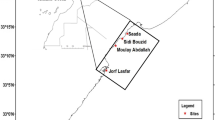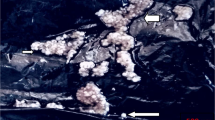Abstract
The effects of wastewater from a mining and ore-dressing mill on fish in Lake Kostomukshskoe, which is used as a cesspool of circulating water and for storage of industrial wastes produced by the Kostomuksha mining and ore-dressing mill in northwest Russia, were studied. The lake is characterized by heavy mineralization, high pH, elevated levels of K+, Li+, SO4 2−, NO2−, Cl−, Li, Mn, and Ni, and the presence of a fine-dispersed mechanical suspension. To assess the impact of contamination on fish and determine the mechanisms of their adaptation, we investigated the biochemical indices and histology of the liver of whitefish (Coregonus lavaretus L.) and pike (Esox lucius L.) inhabiting Lake Kostomukshskoe, downstream Lake Koyvas (64° 47′ 30° 59′), and Lake Kamennoe, which is located in a nature preserve and has not been affected by anthropogenic activity (64° 28′ 30° 13′). Changes were detected in the activity of metabolic enzymes (cytochrome c oxidase (COX), lactate dehydrogenase, and glucose-6-phosphate dehydrogenase) in the liver. Specifically, the COX activity in the liver of both fish species from the contaminated lake decreased, indicating a low level of aerobic metabolism. Lipid infiltration was the most visible and widespread change observed in the liver of both fish species; therefore, it can be considered a marker of such long-term contamination. Lesions in pike liver demonstrated a wider range of severity than in those of whitefish. In summary, metabolic enzyme activity and histomorphology of the liver of whitefish and pike differed among lakes in a species-specific manner. The changes in enzyme activity and histomorphological alterations in fish that were observed can be applied for evaluation of freshwater systems that may be subjected to mineral pollution.











Similar content being viewed by others
References
Aparecida C, Rudnicki M, Melo GC et al (2009) Gills of juvenile fish Piaractus mesopotamicus as histological biomarkers for experimental sub-lethal contamination with the organophosphorus Azodrin® 400. Braz Arch Biol Technol 52:1431–1441
Benejam L, Benito J, Garcia-Berthon E (2010) Decreases in condition and fecundity of freshwater fishes in a highly polluted reservoir. Water Air Soil Pollut 210:231–242
Bergmeyer HU (1974) Methods of enzymatic analysis. Verlag Chemie. Academic Press, Weinheim, Germany
Borvinskaya EV, Nemova NN, Smirnov LP (2011) Glutathione-s-transferase in northern freshwater fish: the effect of water mineralization. Dokl Biol Sci 436:42–44
Bradford MM (1976) A rapid and sensitive method for the quantitation of microgram quantities of protein utilizing the principle of protein-dye binding. Anal Biochem 72:248–254
Gautam RC, Parihar R (1996) Lead and mercury alters lipid contents in liver and kidney of Heteropneustes fossilis. J Zool 16:28–30
Geeraerts C, Belpaire C (2010) The effects of contaminants in European eel: a review. Ecotoxicology 19:239–266
Goolish EM, Adelman IR (1987) Tissue specific cytochrome c oxidase activity in largemouth bass: the metabolic cost of feeding and growth. Physiol Zool 60:454–464
Gül S, Belge-Kurutaş E, Yildiz E et al (2004) Pollution correlated modifications of liver antioxidant systems and histopathology of fish (Cyprinidae) living in Seyhan Dam Lake, Turkey. Environ Int 30:605–609
Hagger JA, Lowe D, Dissanayake A, Jones MB, Galloway TS (2010) The influence of seasonality on biomarker responses in Mytilus edulis. Ecotoxicology 19:953–962
Handy RD, Runnalls T, Russell PM (2002) Histopathologic biomarkers in three spined sticklebacks, Gasterosteus aculeatus, from several rivers in Southern England that meet the freshwater fisheries directive. Ecotoxicology 11:467–479
Hanson N (2009) Utility of biomarkers in fish for environmental monitoring. Integr Environ Assess Manage 5:180–181
Ilmast NV, Sterligova OP (2012) Ichtiophauna of the tailing dump and Lake Okunevoe. In: Nemova NN, Ilmast NV, Ieshko EP, Mescheryakova OV (eds) Biota of the northern lakes under anthropogenic transformation. Karelian Research Centre of Rassina Academy of Sciences, Petrozavodsk, pp 51–56 (in Russian)
Iwaniwicz LR, Blazer VS, Hitt NP et al (2012) Histologic, immunologic and endocrine biomarkers indicate contaminant effects in fishes of the Ashtabula River. Ecotoxicology 21:165–182
Kelly JM (2007) Ecotoxicological assessment of juvenile northern pike inhabiting lakes downstream of a uranium mill. Doctoral dissertation. University of Saskatchewan, Saskatoon
Kohler A, Deisemann H, Lauritzen B (1992) Histological and cytochemical indices of toxic injury in the liver of dab Limanda limanda. Mar Ecol Prog Ser 91:141–153
Konradt J, Braunbeck T (2001) Alterations of selected metabolic enzymes in fish following long-term exposure to contaminated streams. J Aquat Ecosyst Stress Recover 8:299–318
Lapointe D, Couture P (2010) Accumulation and effects of nickel and thallium in early-life stages of fathead minnows (Pimephales promelas). Ecotoxicol Environ Saf 73:572–578
Lozovik PA, Ilmast NV (2012) Hydrological and hydrochemical parameters of Lake Kamennoe. In: Ilmast NV, Ieshko EP, Mescheryakova OV (eds) Nemova NN. Biota of the northern lakes under anthropogenic transformation Karelian Research Centre of Rassina Academy of Sciences, Petrozavodsk, pp 12–16 (in Russian)
Lozovik PA, Kulakova NE (2012) Hydrological and hydrochemical parameters of the tailing dump and Lake Okunevoe. In: Ilmast NV, Ieshko EP, Mescheryakova OV (eds) Nemova NN. Biota of the northern lakes under anthropogenic transformation Karelian Research Centre of Rassina Academy of Sciences, Petrozavodsk, pp 28–38 (in Russian)
Lozovik PA, Kulikova TP, Martunova NN (2007) State of water bodies in Republic of Karelia. By monitoring results. Karelian Research Centre of Rassina Academy of Sciences, Petrozavodsk (in Russian)
Mikodina EV, Sedova MA, Chmilevsky DA et al (2009) Histology for ichthyologists: experience and advices. VNIRO, Moscow (in Russian)
Moiseenko TI (1997) Theoretical bases of critical limit values of antropogeneous loads on subarctic surface waters. Kola scientific centre, Apatity (in Russian)
Moiseenko TI (2008) Aquatic ecotoxicology: theoretical principles and practical application. Water Resour 35:530–541
Nemova NN (2005) Biochemical effects of mercury accumulation in fish. Nauka, Moscow (In Russian)
Nemova NN, Ieshko EP, Meshcheryakova OV et al (2012) The European whitefish, Coregonus lavaretus (L.), under conditions of technogenic pollution in the Kostomuksha tailing pond. Russ J Ecol 43:323–327
Osman AGM, Abd El Reheem AM, AbuelFadl KY, GadEl-Rab AG (2010) Enzymatic and histopathologic biomarkers as indicators of aquatic pollution in fishes. Nat Sci 2:1302–1311
Sahan A, Kurutas EB, Altun T (2010) The determination of biochemical indicators in the common carp (Cyprinus carpio) to the physico-chemical parameters of the Ceyhan River (Adana-Turkey). Ekoloji 19:8–14
Sidorov VS, Nemova NN, Vysotskaya RU, Taksheev SA (2003) Variability of the integrated biochemical index in fish exposed to technogenic water of mining and ore-processing works. Russ J Ecol 34(4):242–247
Smith L (1955) Spectrophotometric assay of cytochrome c oxidase. Methods Biochem Anal 2:427–434
Sokolova SA, Medyankina MV, Anisova SN, Labedev AT (2011) Water quality standards of water bodies with importance for fish industry, including standards of maximum permissible concentration of harmful substance in water bodies with importance for fish industry. Russian Federal Research Institute of Fisheries and Oceanography (VNIRO), Moscow (in Russian)
Stehr CM, Myers MS, Burrows DG et al (1997) Chemical contamination and associated liver diseases in two species of fish from San Francisco Bay and Bodega Bay. Ecotoxicology 6:35–65
Tashev T (1980) Innate and adaptive enzymopathy. Medicine and physical training. Sophia (in Russian)
Tejda-Vera R, Lopez-Lopes E, Sedeno-Diaz JE (2007) Biomarkers and bioindicators of the health condition of Ameca splendens and Goodea atripinnis (Pisces: Goodeaidae) in the Ameca River, Mexico. Environ Int 33:521–531
Van der Oost R, Beyer J, Vermeulen NPE (2003) Fish bioaccumulation and biomarkers in environmental risk assessment: a review. Environ Toxicol Pharmacol 13:57–149
Vasiljeva OB, Nazarova MA, Rippati PO, Nemova NN (2012) Lipid content and lipid peroxidation in fish organs and tissues. In: Nemova NN, Ilmast NV, Ieshko EP, Mescheryakova OV (eds) Biota of the northern lakes under anthropogenic transformation Karelian Research Centre of Rassina Academy of Sciences, Petrozavodsk, pp 175–185 (in Russian)
Wolf JC, Wolfe MJ (2005) A brief overview of nonneoplastic hepatic toxicity in fish. Toxicol Pathol 33:75–85
Yamaguchi S, Celino FT, Ito A et al (2008) Effects of arsenic on gonadal development in freshwater crab, Somanniathelphusa pax, in Vietnam and Geothelphusa dehaani in Japan. Ecotoxicology 17:772–780
Acknowledgments
We are grateful to our colleagues from the Institute of Biology of Karelian Research Centre of the Russian Academy of Sciences (Evgeny P. Ieshko, Nikolay V. Ilmast, Ekaterina V. Borvinskaya, and Irina V. Sukhovskaya) for their valuable help in organizing our field study and collecting fish for analysis. This study was carried out using the facilities of the Scientific Center of Collective Usage Platform of the Institute of Biology of Karelian Research Centre of the Russian Academy of Sciences. This research was supported by grants of the President of the Russian Federation (NSh-1410.2014.4 and МК-3025.2014.4) the Russian Foundation for Basic Research (14-04-00473_а), the Federal Purposeful Program (state contract no. 8050), Programs of the Russian Academy of Sciences “Living Nature” 2012–2014, and “Biological Resources of Russia” 2012–2014.
Author information
Authors and Affiliations
Corresponding author
Additional information
Responsible editor: Philippe Garrigues
Rights and permissions
About this article
Cite this article
Churova, M.V., Murzina, S.A., Meshcheryakova, O.V. et al. Metabolic enzymes activity and histomorphology in the liver of whitefish (Coregonus lavaretus L.) and pike (Esox lucius L.) inhabiting a mineral contaminated lake. Environ Sci Pollut Res 21, 13342–13352 (2014). https://doi.org/10.1007/s11356-014-3014-5
Received:
Accepted:
Published:
Issue Date:
DOI: https://doi.org/10.1007/s11356-014-3014-5




